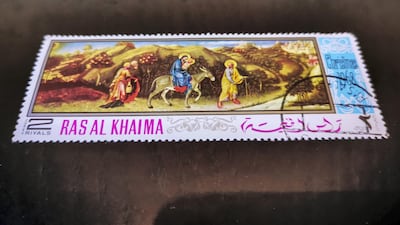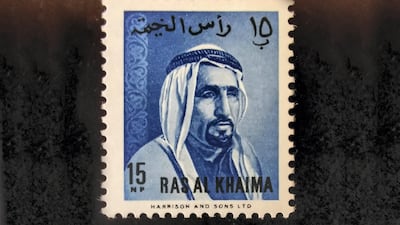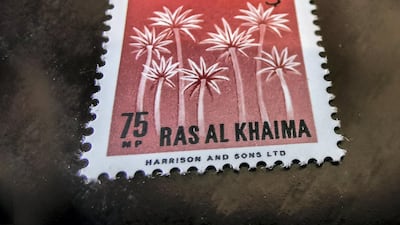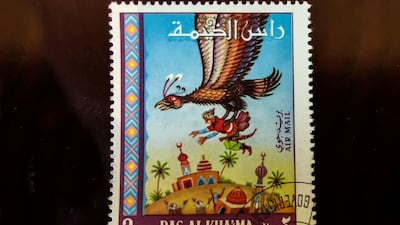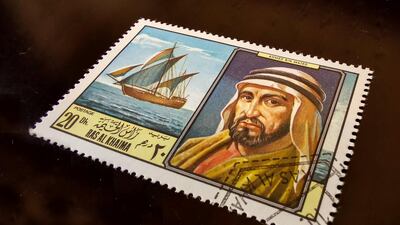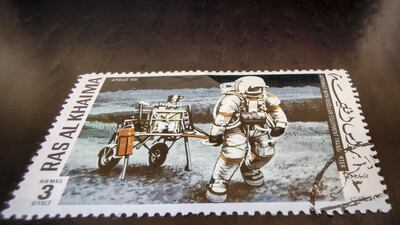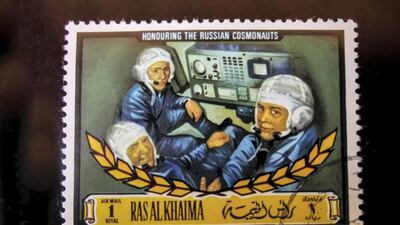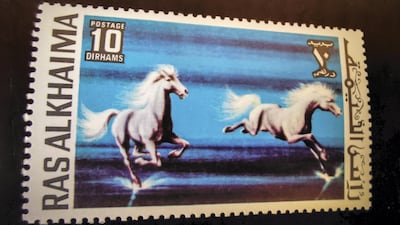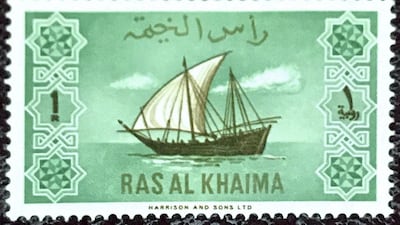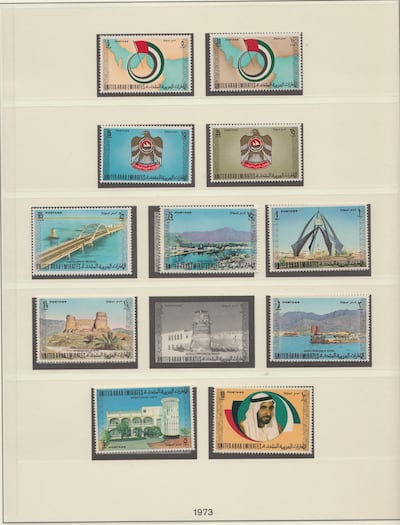History can be found not just in books, but also stuck on the front of an envelope. In the case of the UAE, that colourful square of paper in the top right corner is as good a guide as any to the many twists and turns in the country's story. A display at the RAK Heritage Corner in the Ritz-Carlton in Ras Al Khaimah celebrates the emirate's postage history from the mid-1960s until it joined the union in 1972.
They include the first stamps ever issued by the RAK Government, featuring the late Ruler, Sheikh Saqr bin Mohammed Al Qasimi, as well as palm trees and sailing dhow. They also carry the name “Ras Al Khaima”, the archaic spelling of the emirate and are denominated in Indian rupees. Issued in 1964, the stamps show Ras Al Khaimah on the road to independence, but not fully there.
That was the year RAK set up its own post office, the last of the seven emirates to do so. The currency was rupees, as dictated by the British, who controlled RAK’s external affairs following a series of treaties in the 19th century and the sacking of the city by its troops in 1809. The same was the case for the other six emirates. The long arm of the British Empire can be seen in the postal arrangements for the UAE, then called the Trucial States, for well over 100 years.
It was a group of Karachi merchants living in Dubai who petitioned for a branch of the Indian Postal Service to be opened in the city. They got their wish on August 19, 1909, and for the next 50 years, packages and letters left the city identified by the cancellation mark, identifying the origin as “Dubai”. The stamps used were sometimes British and Indian, after independence in 1947 from Pakistan and, latterly, from Muscat in Oman until 1961 when new Trucial States stamps were issued.
In Abu Dhabi, the system was even more complicated. Few foreigners visited the emirate before the 1950s, and it was only with the arrival of large numbers of engineers and construction workers to explore for oil that there was any real demand for postal services. Many of these lived on Das Island, and from the mid-1950s, post arrived directly from Bahrain, where the British postal agency for Eastern Arabia was based. Letters sent home were given the postmark “Bahrain”, even though they had been sent from the agency office on Das.
That changed in 1963. By now, oil was flowing, and the city of Abu Dhabi expanding almost daily, as the population grew rapidly. In March that year, the British postal agency opened its first branch in Abu Dhabi, and proposed to use its Trucial States stamps, first issued in Dubai, and featuring palm trees and dhows, with denominations from just five naya paisa, of which 100 make a single rupee.
The idea did not meet the approval of the Ruler of Abu Dhabi, Sheikh Shakhbut, who wanted his own stamps. On March 30, 1964, the first Abu Dhabi stamps were issued, featuring the portrait of Sheikh Shakhbut, along with a gazelle, the royal palace at Qasr Al Hosn, and even an oil rig in the desert complete with camels. The stamps were priced with a version of the Indian rupee, known as a Gulf rupee, even though at the time, Abu Dhabi used the Bahraini dinar as its currency.
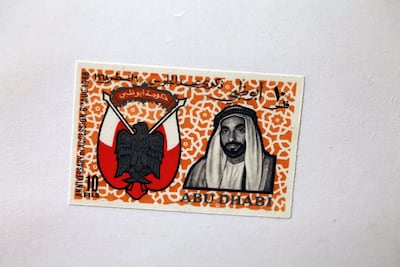
In 1996, there was a transfer of power from Sheikh Shakhbut to Sheikh Zayed, the Founding Father. Initially, the old stamps continued in use, but with the former ruler's portrait obscured by overprinting that also added its value in dinar. Two years later, a new stamp marked the second anniversary of Sheikh Zayed's accession, featuring a portrait of the ruler and the crest of the emirate.
Printed in London by Harrison and Sons, who also produced all the UK’s stamps, it was sold in fils, the lower denomination of the dinar.
By now, the British had relinquished control of postal services across all the seven emirates. Many of the Northern Emirates had been sending post through Dubai, but the changes allowed them to issue their own stamps, and for some, created a business opportunity.
The best-known was Finbar Kenny, an American philatelist who managed the stamp division at Macy's department store in New York. Kenny's greatest achievement had been to arrange the sale of the world's rarest stamp: the British Guiana 1c Magenta, in 1940 for $40,000 (Dh146,900).
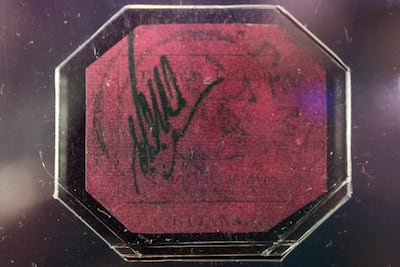
From 1963, Kenny struck a series of deals to produce stamps with several emirates, most notably Ajman and Fujairah. Similar arrangements seem to have been made with other emirates, including RAK. Large, topical and colourful, the stamps featured everything from Michelangelo's Sistine Chapel, the life of American President John F Kennedy and even the Winter Olympics.
The Ritz-Carlton collection, for instance, has two stamps dedicated to the space missions of the 1960s and 1970s, honouring both Russian cosmonauts and Apollo 14, the first craft to land in the lunar highlands and third to land on the Moon.
It has been estimated that RAK alone may have issued more than 900 stamps in this period. Other examples on display include a celebration of 1001 Nights and honouring the 15th-entury explorer Ahmad Bin Majid, who was born in the region. Other known sets marked Mother's Day, featuring the Mona Lisa, famous operas and Vivaldi's Four Seasons, as well as a 1968 stamp to mark Christmas.
Intended for collectors rather than posting, stamps provided an important revenue stream for the poorer emirates, at their peak bringing around £70,000 (Dh332,376) a year according to a 1969 report in the British newspaper, The Times, or the equivalent of about Dh5 million today.
Ajman even produced a series of nine editions from its tiny enclave of Manama, opening a post office there in July 1966, so that they could be properly franked. Known collectively as “dunes” by international collectors, these stamps were produced in such vast quantities that their value inevitably plummeted. Most of them are no longer even listed in collector’s catalogues. Nor did things end well for Kenny, who was eventually convicted and heavily fined over a deal he struck with the Cook Islands, after revenue intended for a government pension fund ended up paying for the then prime minister’s election campaign.
Order was restored in December 1971, with the formation of the UAE, although it would be another two years before the new federation got its own stamps. In the interval, Ajman continued to issue its own stamps. A national postal service was set up in 1972, and with the creation of the UAE dirham in 1973, everything was set for the new country to issue the first postage stamps in its own currency.
The first UAE stamps include a portrait of Sheikh Zayed, along with selected images of each of the emirates, including the new Maqta bridge in Abu Dhabi, the Deira Clock Tower in Dubai and the Ruler’s Palace in Ajman. Other stamps featured a map of the Arabian Gulf, with the UAE shown by a flag and the country’s new falcon crest. They ranged in value from 5 fils to Dh1.25.
Since then, Emirates Post has continued to issue stamps, both for regular postage and special commemorative editions and first day covers. Its latest stamps mark the visit of Pope Francis, the Abu Dhabi Tour cycle race, the Sheikh Zayed Heritage Festival and Dubai Police.
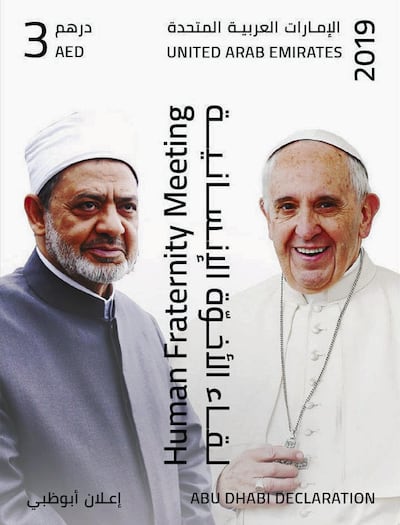
Despite the proliferation of worthless "dunes", some older stamps remain sought after, according to Stanley Gibbons, a haven for stamp collectors. They might not reach the $9.4 million last paid for the British Guiana Magenta, but the first overprinted Abu Dhabi stamps will still set you back about Dh1,500. On eBay, a 1971 sheet of 5 fils stamps showing Sheikh Zayed but with an Arabic letter misprinted, is currently offered for $2,700.
Plus $15 for postage, of course.
